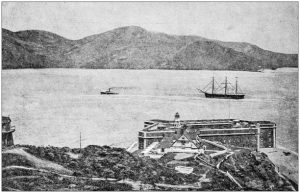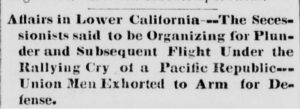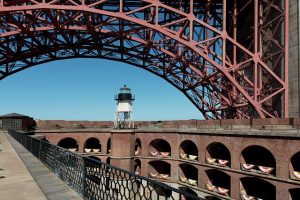Albert Sidney Johnston at Fort Point: Where Narratives Collide
Emerging Civil War welcomes back guest author Katy Berman…
Fort Point, a National Historic Site at the tip of the San Francisco Peninsula, was built to deter a naval invasion of California. It was completed on the eve of the Civil War and served as headquarters for the Department of the Pacific. Not a single shot was fired from Fort Point during that war or after, but its value was recognized by Joseph Strauss, chief engineer for the Golden Gate Bridge. He urged his team to find a way to preserve the old fort; the result is a magnificent golden arch framing and protecting this Civil War relic.[1]

While taking a tour of Fort Point years ago, I heard a story that stayed with me. Time passed, details faded from my memory, but the tale’s dramatic force remained. Fort Point’s first commander, I was told, was Kentucky-born, a man who would later fight for the Confederacy. One evening, in 1861, he was approached by a group of men, southern sympathizers like himself. Their intention, and their expectation, was to enlist his support in a plot to seize the military installations ringing the Bay. California would be turned into an independent republic, and its resources, particularly its gold, made available to the nascent Confederacy. The commander would, days later, resign from the United States Army, but for the moment he was in its employ. He stunned the plotters by turning them down, and added, thrillingly, “I will defend the property of the United States Government to the last drop of blood in my body.” That was how I remembered it.
I later discovered that Fort Point’s heroic commander was no minor figure, but rather Albert Sidney Johnston, a man Jefferson Davis considered “the finest military officer in the United States.”[2] Intrigued, I wanted to know the details of Johnston’s last, heroic defense of the Union. The details I uncovered do not always fit neatly with my recollections.
Johnston commanded the Department of the Pacific for only three months, from January 14 through April 25, 1861. His tenure was not marked by unusual activity. There were altercations in the Gold Country between miners and Native Americans; those required Johnston’s attention and diplomacy.[3] The department was impoverished and greatly in debt, a situation Johnston had less control over. “The Government,” he moaned,” has allowed every department of the staff here to fall into a state of pauperism making the military arm as impotent for action here as the greatest enemy of the republic could desire to have it.”[4]

“Those were days of a good deal of distrust and bitterness,” and California’s remoteness did not keep sectionalism at bay.[5] Los Angeles County contained pockets of southern sympathizers, but San Francisco, as described by Johnston in a letter dated January 25, “is decidedly in favor of the Union.” A large pro-Union meeting was held in that city a month later, and Johnston lamented in a subsequent letter, “I would that there were no other sentiments within the broad expanse of our country.”[6] There was, however, fear among Californians, even in San Francisco, that their state would secede. Suspicions of treason–or potential treason–began to attach themselves to the southern-born general. San Francisco’s military stores and fortifications were his to command, and his to release to the secessionists if he so chose.
It is uncertain how the rumors began. Perhaps it was when Abraham Lincoln was elected President, and California senator cum absentee Mississippi slaveholder, William Gwin, journeyed east in alarm. There, he urged outgoing Secretary of War John Floyd, a man of southern principles, to remove all loyal officers from their posts. [7] Johnston, although his predecessor had died rather than been removed, was given his California commission about that time.[8] By spring, the chief elements of a conspiracy theory were in place. The Nevada Democrat (Nevada, CA) reported in its April 30 issue that information about a conspiracy had reached President Lincoln, that there had been “a great danger that California would secede and declare an independent Pacific Republic.” It was charged that “Federal officeholders would refuse to deliver their trusts to their appointed successors.” Johnston was suspected of either furthering or turning a blind eye to those efforts. Lincoln and his cabinet sent Brig. Gen. Edwin V. Sumner to relieve Johnston, which he did, dramatically, within an hour of docking in San Francisco.[9]

There are variations to the narrative. In one, General Winfield Scott, “was unwilling to depend upon Johnston’s honor,” and it was he that sent Sumner to San Francisco.[10] In another version, Sumner arrives incognito, the better to take Johnston by surprise.[11] One colorful account, published by The Sacramento Bee in 1895, recalls how the Bee’s founding editor, James McClatchy, was called to the bedside of a dying secessionist. There he learned of Johnston’s perfidy. McClatchy sent a message by pony express to Oregon senator Edward Baker who passed it on to Lincoln. When Sumner arrived in San Francisco a month later, he rushed to Johnston’s office and ordered him to surrender his commission. Thus, “California was saved, and the honor belongs to James McClatchy.”[12]
William Preston Johnston, in an 1878 biography of his father, includes testimonials to the General’s innocence. Among these is a refutation of the conspiracy theory written by John Downey, former Governor of California. “Now I say that it is not true that there was any plot to carry this state out of the Union,” Downey insists. He had, nevertheless, visited Johnston at some point with concerns that the “75,000 stands of arms at Benicia” might be used against the government. At that meeting, Johnston, curiously, addressed what Downey did not say. “Governor,” he began, “I have spent the greater part of my life in the service of my country, and while I hold her commission, I will serve her honorably and faithfully. I shall protect her public property, and not a cartridge or percussion-cap will pass to any enemy while I am here as her representative.”[13]
Johnston told Downey that although he was “sorely afflicted” by disunion, Texas “may control my future destiny.” Indeed, when Johnston learned of Texas’ secession on April 9, he wrote his letter of resignation. It was sent, on the 10th, by Pony Express, and Johnston anticipated it would arrive by April 25. He continued to be true to his commission and, at some point, moved the stand of arms from Benicia to Fort Alcatraz, located on an island in San Francisco Bay.[14]
Careful not to deflate the morale of his men, Johnston informed only a handful of intimates of his resignation. He did not believe secession was the answer, but, as he confided to son William, Johnston could “find no justification in his conscience,” for not following his adopted state. The same letter alludes to a “paragraph in the papers to the effect that evidence is in possession of the War Department that General Johnston and other officers are conspiring to establish a Pacific Republic.” [15]
Johnston was “disgusted” that the War Department did not investigate the accusations leveled against him, indignant that they allowed him to be publicly shamed.[16] The shaming had reached national proportions, as confirmed by a letter from Johnston’s sister-in-law, Eliza Gilpin, dated April 15 from Philadelphia. Mrs. Gilpin was astonished after reading in a newspaper that her “brother” had been “superseded in command,” without any stated cause. She implored him to swallow the offense and remain with the Union.[17]
Sumner’s arrival in San Francisco on April 24 pleased Johnston, but made him even more scornful of the War Department. He had expected his letter would arrive in Washington on the 25th; how did his replacement happen to appear the day before?
In truth, President Lincoln had acted on warnings, we cannot be sure of the sources, that Johnston was about to turn over arms and fortifications to secessionists. On March 25, Lincoln ordered Johnston to be replaced by Sumner who was told to sail to San Francisco unannounced. While Sumner was en route, word reached Washington that Johnston had secured the arms at Benicia, and was putting 51 cannon in place at Fort Point. On April 28, Sumner, who had waited a day after his arrival to meet with Johnston, reported that he found everything in good order. Although Johnston had sent in his resignation, he “was carrying out the orders of the Government.”[18]
Many in the East realized the affair had been mishandled and tried to keep Johnston in the Union. Fitz John Porter, who had served as Johnston’s adjutant during the Mormon Wars, assured him that he possessed General Scott’s unwavering confidence and regard. Lincoln himself had second thoughts, and accepted the advice of Montgomery Blair, postmaster general, to offer Johnston a commission of major general. The offer was never received. It was then July, and Johnston was riding back to Richmond to meet with Jefferson Davis.[19]
Enter Asbury Harpending, a flamboyant adventurer and reconstructed rebel whose memoirs appeared in 1913. The Great Diamond Hoax and Other Stirring Incidents in the Life of Asbury Harpending includes a chapter, “Story of Southern Plan to Make California Secede From the Union is Told for First Time.” Harpending’s account is certainly embellished, but a number of its details are familiar. A secret society, the “Committee of Thirty,” of which Harpending was a member, devised plans to seize San Francisco’s military installations in January, 1861. They were aware of Johnston’s reputation and planned to work around him: “No one who knew the man and his exacting sense of honor doubted his absolute loyalty to any trust.”[20]
One committee member, Edmund Randolph “who was close to Johnson,” made him an unauthorized visit, perhaps to gain his support for the plot. He was rebuffed, went “stark crazy,” and became increasingly indiscreet. Harpending believed it was Randolph that “actually wrote the letter to Lincoln,” warning him of the secessionist plot, and “questioning the trustworthiness of General Johnston.” Randolph, who became an outspoken secessionist, died the following September, too late for the Sacramento Bee narrative.
Harpending and two others decided to call upon the general in order to form an opinion of what he knew. Johnston greeted them cordially, and then said in an offhand manner:
“Before we go further, there is something I want to mention. I have heard foolish talk about an attempt to seize the strongholds of the government under my charge. Knowing this, I have prepared for emergencies, and will defend the property of the United States with every resource at my command, and with the last drop of blood in my body. Tell that to all our Southern friends.”
The gig was up. The young and impetuous Harpending wanted to proceed, but was heavily outnumbered. Their forsaken scheme “vanished into the vast, silent limbo of the past.”[21]

Everyone loves a good story, including the storyteller. We cannot be sure that Albert Sidney Johnston took seriously the threat of a secessionist plot, faced down conspirators or made the sublime speeches attributed to him. What we do have is a verified and pithy report that on April 25, he left his department “in good order.” Considering the state of the country and the state of his own feelings, that is high commendation indeed.
————
[1] National Park Service. “History and Culture,” Fort Point National Historic Site, California. https: //www.nps.gov/fopo. Accessed Nov. 22, 2020.
[2] National Park Service. “Civil War at Alcatraz,” Golden Gate National Recreation Area. https://www.nps.gov/goga. Accessed Nov. 22, 2020.
[3] Charles P. Roland. Albert Sidney Johnston: Soldier of Three Republics. (Austin; University of Texas Press, 1964), pg. 243.
[4] Albert Sidney Johnston to Major Fitz-John Porter, Feb. 25, 1861 in The Life of Albert Sidney Johnston, Comprising His Services in the Armies of the United States, the Republic of Texas, and the Confederate States. William Preston Johnston (NY: D. Appleton and Co.,1878,) pg. 270. Google Books.
[5] General Don Carlos Buell to William Preston Johnston, April 2, 1873 in The Life of Albert Sidney Johnston, pg.263.
[6] ASJ to FJP, Jan. 17 and Feb. 25, 1861 in The Life of Albert Sidney Johnston, pg.270.
[7] Benjamin Franklin Gilbert. “The Mythical Johnston Conspiracy,” The California Historical Society Quarterly 28, #2 (June, 1948):
[8] Roland. Albert Sidney Johnston: Soldier of Three Republics, pg. 241.
[9] The Nevada Democrat. (Nevada, CA, April 30, 1861), pg.2. https://chroniclingamerica.loc.gov.
[10] Richard Selcer. Hurry Home! The War’s Beginning Stranded the Confederacy’s Best and Brightest Out West (Civil War Times, Online Only) https://www.historynet.com/hurry-home.htm.
[11] Johnston, The Life of Albert Sidney Johnston,pg.264.
[12] McClatchy and Co. Sacramento County and Its Resources: Our Capitol City Past and Present: A Souvenir of The Bee. 2nd ed. (McClatchy and Co., Sacramento, California, 1895), pg. 156.
[13] John Downey to the Editor of the Express, in Johnston, The Life of Albert Sidney Johnston, pg. 264.
[14] Roland. Albert Sidney Johnston, pg. 246.
[15] ASJ to WPJ, April 9, 1861, in Johnston, The Life of Albert Sidney Johnston, pg. 270-271.
[16] ASJ to Eliza Gilpin, June 1, 1861, in The Life of Albert Sidney Johnston, pg. 274.
[17] Eliza Gilpin to ASJ, April 15, 1861 in The Life of Albert Sidney Johnston, pg. 271.
[18] Johnston, The Life of Albert Sidney Johnston, pg.263.
[19] Montgomery Blair to ASJ, date unknown, in The Life of Albert Sidney Johnston, pg. 267.
[20] Asbury Harpending. The Great Diamond Hoax and Other Stirring Incidents in the Life of Asbury Harpending. (San Francisco, The James H. Barry Co., 1913): pg. 25-35.
[21] Harpending, The Great Diamond Hoax, pg. 38.
Nice to read about my state in this blog. California has such interesting ties to “da war.” When someone talks about Trans-Mississippi, I always go waaaaay west! Good job–and Ft. Point is, indeed, a lovely place.
ASJ was also a very decent guy. He resigned his commission to care for his ailing wife. The lady died and then he came to Texas. Nice post. Thanks!
Fascinating. The dates of this whole episode are pretty interesting, considering that Fort Sumter was on April 12-13. That means Johnston sent in his resignation two days before Sumter, and was replaced 11 days after. How quickly did Californians find out that the first shots had been fired?
researching for any info on the army units roster. orders etc serving in calf at this time .